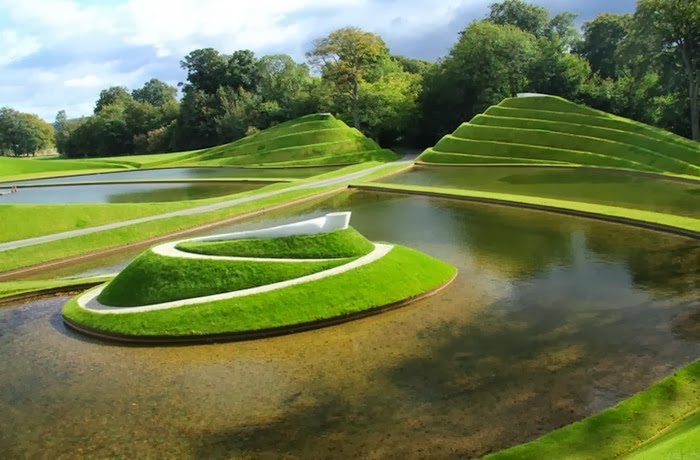Charles Jencks: The Garden of Cosmic Speculation
CLICK ON IMAGES FOR LARGE FORMAT
Here's what Charles Jencks says about his stupendous work of landscape architecture, some of which he designed himself, and some of it by others.
Jencks is known as the leading theorist of postmodern architecture. It's hard to pin postmodernism down, but if you asked me, I'd say it accepts fragmentation and celebrates eclecticism, irony, and humor. Wikipedia confirms this and clarifies that this was in reaction to modernism's self image as a total and standardized aesthetic. My first introduction to postmodern architecture happened when I heard Robert Venturi lecture on it back in the 80s. He's famous for tweaking Mies van der Rohe's maxim "Less is more" into "Less is a bore."
I actually had some personal contact with the Jencks family many years ago. When we moved to Somerville so I could do graduate work in theological studies at Harvard Divinity School, I signed up for part time work through something called Harvard Student Agencies. The work could be brutal, like moving furniture. It could also be great, even inspiring, like when I was assigned to help catalog the work and writings of the composer Gardner Jencks, sometime after his death, in preparation for them to be archived at one of the local universities.
Gardner was father of Charles, and also of Penelope Jencks, who is an accomplished sculptor here in New England. She supervised the work along with the music professor in charge of the archiving. The Jencks house sat at the end of a fairly wooded cul de sac in mid-Cambridge, not far off Brattle Street, and it felt a bit like being in the country. The main living area was large enough to easily feature a grand piano, and the whole place had a somewhat ramshackle bohemian vibe. It was a pleasure to be there for a week or two. It remains a treasured sensory memory.
Gardner was a modernist composer, somewhat like Morton Feldman, I think. In listening to an album of his piano pieces, which Gardner's grandson Edwin gave me, I heard that one of his purposes was to find a way to create an impression of the music existing outside of a regular pulse or rhythm, with an avoidance of obvious pattern; to create a sense of suspension. In looking at some of his scores I could see that one way he achieved this was to assign a different time signature to each bar of music.
Note: This post came about because I was listening to Michael Gandlofi's contemporary classical work inspired by and named for the Garden of Cosmic Speculation.
Here's what Charles Jencks says about his stupendous work of landscape architecture, some of which he designed himself, and some of it by others.
Forty major areas, gardens, bridges, landforms, sculptures, terraces, fences and architectural works. Covering thirty acres in the Borders area of Scotland, the garden uses nature to celebrate nature, both intellectually and through the senses, including the sense of humor. A water cascade of steps recounts the story of the universe, a terrace shows the distortion of space and time caused by a black hole, a "Quark Walk" takes the visitor on a journey to the smallest building blocks of matter, and a series of landforms and lakes recall fractal geometry.
Jencks is known as the leading theorist of postmodern architecture. It's hard to pin postmodernism down, but if you asked me, I'd say it accepts fragmentation and celebrates eclecticism, irony, and humor. Wikipedia confirms this and clarifies that this was in reaction to modernism's self image as a total and standardized aesthetic. My first introduction to postmodern architecture happened when I heard Robert Venturi lecture on it back in the 80s. He's famous for tweaking Mies van der Rohe's maxim "Less is more" into "Less is a bore."
I actually had some personal contact with the Jencks family many years ago. When we moved to Somerville so I could do graduate work in theological studies at Harvard Divinity School, I signed up for part time work through something called Harvard Student Agencies. The work could be brutal, like moving furniture. It could also be great, even inspiring, like when I was assigned to help catalog the work and writings of the composer Gardner Jencks, sometime after his death, in preparation for them to be archived at one of the local universities.
Gardner was father of Charles, and also of Penelope Jencks, who is an accomplished sculptor here in New England. She supervised the work along with the music professor in charge of the archiving. The Jencks house sat at the end of a fairly wooded cul de sac in mid-Cambridge, not far off Brattle Street, and it felt a bit like being in the country. The main living area was large enough to easily feature a grand piano, and the whole place had a somewhat ramshackle bohemian vibe. It was a pleasure to be there for a week or two. It remains a treasured sensory memory.
Gardner was a modernist composer, somewhat like Morton Feldman, I think. In listening to an album of his piano pieces, which Gardner's grandson Edwin gave me, I heard that one of his purposes was to find a way to create an impression of the music existing outside of a regular pulse or rhythm, with an avoidance of obvious pattern; to create a sense of suspension. In looking at some of his scores I could see that one way he achieved this was to assign a different time signature to each bar of music.
Note: This post came about because I was listening to Michael Gandlofi's contemporary classical work inspired by and named for the Garden of Cosmic Speculation.



Comments
Post a Comment